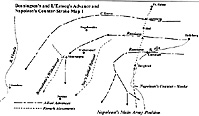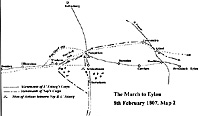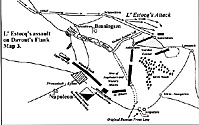Anyone who has studied the battle of Waterloo is aware of the importance of the Prussian Army's intervention and thus their contribution to the French Army's defeat on that memorable day. However, many Napoleonic enthusiasts are not so aware of another important Prussian Army intervention eight years before the battle of Waterloo.
This intervention occurred at the battle of Eylau in 1807 and not only robbed Napoleon of certain victory but saved the Russian Army from another Austerlitz. The objective of the following essay is to put before the reader an account of this earlier and just as important intervention by the Prussian Army.
After the battles of Pultusk and Golymin in December 1806, Napoleon had ordered his Army into winter quarters along the Vistula in south-western Poland, primarily because of bad weather but also because of his inability to defeat the Russians in a decisive battle that December. His troops of course needed rest and recuperation after their efforts in Prussia that year.
The Russians, however, had other ideas. Being better acclimatised to the weather in Eastern Europe, their Hanoverian Commander-in-chief - General of Cavalry Baron Levin August Benningsen - had decided to use the natural cover provided by the Great Forest of Johannisburg to surprise and destroy at least one or maybe two of Napoleon's spread out army corps. This good plan may well have worked out very well indeed and may have had serious consequences for the French position in Poland but for one unforeseen development.
Impetuous Ney
Marshal Ney, Commander of Napoleon's 6th Corps d'Armée, had taken it upon himself to advance his corps forward, despite clear orders not to, in the search for food as his had been suffering particularly badly from the lack of it. Running head first into Benningsen's advance he was able to warn the Russian general's intended victim (his good friend Marshal Bernadotte) of the danger as well as his Imperial master. Napoleon's initial reaction is well known. Ney received a good reprimand but the Emperor also realised the opportunity it represented, especially if Ney and Bernadotte could lure Benningsen on whilst he assembled the remainder of his corps to strike Benningsen in the flank.
It was during these actions that Ney, coming up on Napoleon's left, encountered the Prussian Army Corps under General Anton Wilhelm von L' Estocq, which was then serving with Benningsen's Russian Army. Ney and L' Estocq had already fought each other in December of 1806 at Soldau and were now to encounter each other in a series of fierce encounters, as Napoleon had directed Ney to prevent the Prussians from joining up with Benningsen as he retreated through Bergfried and Hof.
L' Estocq's Prussian Corps had formed part of the Russian right wing when it had advanced on Bernadotte in late January, although not involved in the battle of Mohrungen where Bernadotte had defeated General Markov, the Russian right wing's advance guard commander. It shortly afterwards received Benningsen's order to retreat. The Prussians were the most exposed of Benningsen's forces, having just relieved and re-supplied the Prussian garrison of Graudauz on the Vistula.
Happily Bernadotte had moved off toward the main French army so L' Estocq began his retreat unmolested, that is until he came upon the French left on the 5th February near the town of Waltersdorf and had the first of his encounters with Marshal Ney. Heavily outnumbered and receiving a bit of a drubbing, L' Estocq was forced to sacrifice his advance guard, which was driven back on Mohrungen whilst L' Estocq reached Wuzen that night with his main body of troops.
The following day Ney was recalled to the main French Army at Landsberg and L' Estocq was thankful far his escape, reaching Enqelswalde, within easy reach of the Russian right that night. Ney's recall had occurred because Napoleon had thought that Benningsen would fight at Landsberg, instead he slipped away toward a town called Preussisch-Eylau.
Murat in the Lead
On the 7th February 1807 when Marshal Murat, the Grand-Duke of Cleve Berg, led the advance guard of the main French Army out of the woods above the town of Preussisch-Eylau and entered onto the Ziegelhof plateau, he found before him the Russian rear guard under Prince Bagration. Confident of prompt support from Marshals Soult and Augereau, Murat, at about 2pm, opened what has gone down in history as the battle of Eylau. Ably supported by Soult, Murat cleared the plateau of Ziegelhof after a stiff fight and everything seemed to be over for the day when some French regiments followed Bagration's retiring troops into Eylau itself, no doubt wishing to secure the town for night against the prevailing winter weather. Unfortunately, the Russians mistook this for a further attack and consequently a vigorous and intense fight for the town developed as each side fed in regiment after regiment, and Eylau itself became progressively uninhabitable. Eventually though the Russians give up the fight and drew off their regiments to a position that overlooked Eylau and its environs. The night proved to very cold and both sides suffered through lack of cover but this was nothing compared to what the morning held in store for them.
The 8th February 1807 broke gloomy and wild, the clouds were heavy with snow and the winds blew in the North making not only visibility but command difficult in the whirling snow storms, indeed, Marshal Davout for one, likened this combat to a night action.
Benningsen opened the battle at about 8am with a fierce bombardment of Eylau completing the work of the previous night and causing such casualties that Napoleon decided to launch a limited attack with his left wing to divert Benningsen's attention. The Russian reaction however was more then Napoleon had expected and he found himself forced to attack elsewhere to ease the pressure on his left wing, where the Russian's had counter-attacked with unforeseen vigour.
To disengage his left wing, Napoleon ordered Marshal Augereau supported by a division of Marshal Soult's to attack the Russian left but at that moment the weather worsened to bring disaster upon Augereau's troops. A sudden snowstorm, driving into the faces of Augereau's men, caused them to attack the Russian centre instead of the left - the result was frightful. Benningsen's guns, who had been happily pouring a steady stream of projectiles into Eylau, now switched to grape and half destroyed Augereau's divisions before the Russian horse cantered forward and completing the job with the sabre. Within 30 minutes Augereau's once proud regiments, except for a few hard core die-hards, were fleeing for their lives.
Meanwhile Soult's division, St. Hilaire, found himself all alone facing the Russian left and had the greatest difficulty in extracting himself from the triumphant Russians. Napoleon himself also had a near escape as the triumphant Russians from the centre try to capitalise on their success and retake Eylau but the French Imperial Guard intervened successfully to save their idol.
L' Estocq's men are tired, but L' Estocq unlike Ney, is aware that a major battle is in progress towards Eylau and has just received firm orders from Benningsen to come to his assistance. Ney will only receive orders from Napoleon at 2pm on the 8th February because of the weather and the courier's difficulties in finding him.
Up to that moment Ney will be unaware that a battle is taking place at Eylau and Napoleon has urgent need of his troops, he will also be involved in his own series of actions against L' Estocq. (Apparently, the snow and winds had a deadening effect upon the sound of the battle and only upon approaching the field of action could, L' Estocq for instance, glimpse the cannon flashes of the battle though he could not hear a thing).
L' Estocq's plan is to march direct for Eylau via Wackern, Schlautienen, Goerken and Althof but is only able to start at 8am because of the tired nature of his troops. By which time Ney, obeying his last set of orders, is on the road to Kreutzburq. Consequently as L' Estocq's advance guard, the Auer Dragoons, Towarczys Uhlans and von Breda's horse battery are emerging from the woods near Schlantienen, Ney is observed approaching from the village of Bornehren and will reach Schlantienen before L' Estocq's main body. L' Estocq quickly deploys his advance guard to delay Ney's advance whilst instructing his main body to march for the town of Pompicken from Wackern, his main body thereby taking a more northerly route, heading for Pompicken and Graventien, instead of Schlautienen and Goerken.
However, Ney had also sent some of his troops toward Wackern and L' Estocq is compelled to react here too, deploying infantry companies from the Wyburg and Schoeing regiments in the woods about Wackern to delay Ney's troops whilst the main body of his own force gets safely away to Pompicken. Successful though these delaying actions are, the rearguard of L' Estocq's Corps now seems to be hopelessly cut off, Wackern having now fallen to Ney's forces. Colonel Stutterheim's fusiliers, however, have other ideas and boldly retake Wackern but the rest of the rearguard do not support them quickly enough and Stutterheim is pushed out by a fierce counter-attack. The rearguard, like the main body before is forced to make a wide detour before rejoining L' Estocq at Pompickern.
Pompickern
Withdrawing when L' Estocq's main body is clear, they find themselves under continuous attack as they follow L' Estocq's march through Graventien and Althof. It is during this period of fighting that Ney receives the order to join Napoleon's left at Eylau, but L' Estocq arrives on the field of battle before Ney, and detaching Schlieffen's Grenadiers to hold Althof marches to Benningsen's assistance, who by now is in a little trouble.
Since we left the battle of Eylau, Davout's troops had made an appearance and slowly but surely turned the Russian left until it was at right angles to the rest of the army and in great danger of collapsing altogether, victory it seemed was within easy reach of the French.
It was about 5pm and what light there had been during the day was beginning to fade and it was also now that L' Estocq made his presence felt. He had reached Althof around noon and had deployed on the Russian right only to receive a frantic order to move to the assistance of the Russian left. Naturally enough it took some time for him to re-deploy and march over to the Russian left, but during his march it became obvious that Davout's troops were positioned in such a way that if he took the key village of Kutschitten, he could outflank Davout and roll him up. This is what L' Estocq intended to do.
With the infantry regiments Wyburg and Ruchel leading the advance L' Estocq directed his attack on Kutschitten, storming this village with the bayonet he drove Davout's troops defending it onto the lances of the Towarczys regiment, which had swung round the left of the village.
Having captured the village, taken care of its defenders and captured their eagle in the process, L' Estocq realigned his corps, putting the infantry in the first line and the cavalry in the second. He now advanced upon the great Birch wood that lay between the hamlets of Anklappen and Lampasch, where Davout had established his new line of defence. L' Estocq's infantry advanced as if on parade, nothing checking their cool resolution, until they halted within musket shot of Davout's troops.
They and their accompanying artillery then commenced a tremendous fire that lasted half an hour and caused heavy casualties amongst Davout's troops. Then L' Estocq's infantry charged with the bayonet and drove Davout's troops from the Bitch wood and chased them toward the village of Klien-Sausgarten, where they were halted by a battery which Davout had personally placed near that village. During the fight for the Birch wood the Russian left had rallied and come to L' Estocq's support successfully storming the hamlet of Anklappen to his right. L' Estocq, now checked by Davout's battery, retired to the Birch wood to rest his men.
They had now fought and marched for 12 to 14 hours in the most severe winter conditions and in the process had once more established the old fame of Prussian bravery, resolute courage and skilfulness in manoeuvring. The battle of Eylau was at an end, Davout's turning movement had been thwarted and the Russian army had survived to fight another day. It was also a moment to forget the disaster of Jena-Auerstadt and hope that fortune may yet herald victory for the Russo-Prussian alliance.
What of Ney?
But what of Ney? Having failed to stop L' Estocq from reaching and saving the Russians, he arrives at Althof, much delayed, pushes aside the Schlieffen Grenadiers but signally fails to have any real influence on the battle of Eylau.
During the night, despite the protests of several of his generals, including L' Estocq, Benningsen retires from the battlefield of Eylau having administered a decided check upon Napoleon and the much vaunted Grande Armée.
L' Estocq's contribution to the battle cannot be faulted, the rearguard actions of Schlautienen, Wackern and Pompicken, the attacks on Kutschitten and the Birch wood, did the regiments involved great credit and helped restore some of the honour lost during the Autumn campaign of 1806 by the Prussian Army. Indeed, when Frederick William III reorganised his Army in 1807, the regiments present at Eylau were some of the few to be retained as he disbanded the majority of his army in disgust at its performance in 1806.
Lastly, L' Estocq not only performed a valuable service to the Russian Army at Eylau but kept Ney away from that memorable field when desperately needed by Napoleon. Thus, L' Estocq and his Prussian corps undoubtedly deserve to be remembered for one of the remarkable and memorable interventions of military history.
Chandler, David G., The Campaigns of Napoleon, (New York: Macmillan, 1966. Reprint London: Weidenfeld and Nicolson, 1987).
 Indeed, all went as Napoleon desired but then ill-luck intervened and Benningsen learnt from a captured despatch of Napoleon's intentions and reacted accordingly, though only just avoiding Napoleon's envelopment in the process and having to fight a series of fierce rearguard actions at Bergfried and Hof.
Indeed, all went as Napoleon desired but then ill-luck intervened and Benningsen learnt from a captured despatch of Napoleon's intentions and reacted accordingly, though only just avoiding Napoleon's envelopment in the process and having to fight a series of fierce rearguard actions at Bergfried and Hof.
 By the 7th February Ney had reached Landsberg and camped there for the night, preparing to follow a new to march on Kreuzburg the following day. That same night L' Estocq arrived at Hussehnen, a mere 7 miles from Eylau to the North West.
By the 7th February Ney had reached Landsberg and camped there for the night, preparing to follow a new to march on Kreuzburg the following day. That same night L' Estocq arrived at Hussehnen, a mere 7 miles from Eylau to the North West.
 Pompickern itself is soon under attack as Ney, having taken both Schlautienen and Wackern, follows up no doubt hoping to bring L' Estocq to a general action. However, yet again, L' Estocq only deploys the minimal of troops to delay Ney as he continues his march. This time Major von Fabecky's Grenadiers are ordered to hold Pompickern and supported by von Wagenfeld's Cuirassiers and Rental's artillery, they repulse all of Ney's attacks.
Pompickern itself is soon under attack as Ney, having taken both Schlautienen and Wackern, follows up no doubt hoping to bring L' Estocq to a general action. However, yet again, L' Estocq only deploys the minimal of troops to delay Ney as he continues his march. This time Major von Fabecky's Grenadiers are ordered to hold Pompickern and supported by von Wagenfeld's Cuirassiers and Rental's artillery, they repulse all of Ney's attacks.
Sources and Further Reading
-----------------,ed., Napoleon's Marshals , (London: Weidenfeld & Nicolson, 1987) Esposito, Vincent J., & Elting,
John R., A Military History and Atlas of the Napoleonic Wars , (New York: Praeger, 1968. Reprint London: Arms and Armour Press, 1980).
Hayman, Sir Peter, Soult: Napoleon's Maligned Marshal , (London: Arms and Armour Press, 1990).
Horricks, Raymond, Marshal Ney: The Romance and the Real , (Tunbridge Wells: Midas Books, 1982).
Petre, F. Lorraine, Napoleon's Campaign in Poland 1806-07 , (London: Bodley Head, 1907 Reprint. London: Greenhill Books, 1989).
Wilson, Sir Robert, Campaigns in Poland 1806 and 1807, (London: C. Roworth, 1810 Reprint. Felling, Worley Publications, 1995).
Back to Table of Contents -- First Empire #36
Back to First Empire List of Issues
Back to MagWeb Master Magazine List
© Copyright 1997 by First Empire.
This article appears in MagWeb (Magazine Web) on the Internet World Wide Web. Other military history articles and gaming articles are available at http://www.magweb.com